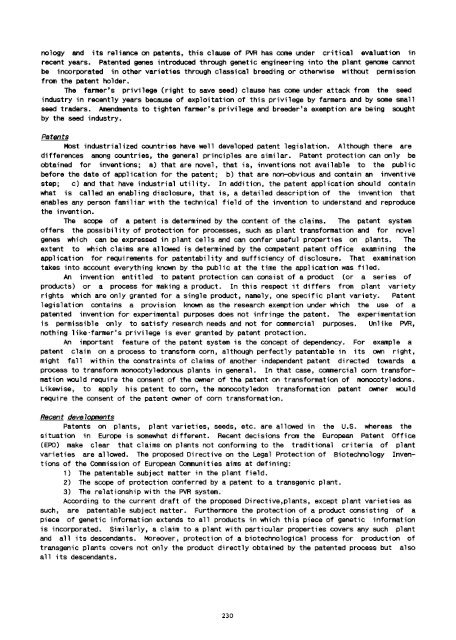Proceedings of the Fifth Asian Regional Maize Workshop - Search ...
Proceedings of the Fifth Asian Regional Maize Workshop - Search ...
Proceedings of the Fifth Asian Regional Maize Workshop - Search ...
Create successful ePaper yourself
Turn your PDF publications into a flip-book with our unique Google optimized e-Paper software.
nology and its reliance on patents, this clause <strong>of</strong> PYA has come under critical evaluation in<br />
recent years. Patented genes introduced through genetic engineering into <strong>the</strong> plant genome cannot<br />
be incorporated in o<strong>the</strong>r varieties through classical breeding or o<strong>the</strong>rwise without permission<br />
from <strong>the</strong> patent holder.<br />
The farmer's privilege (right to save seed) clause has come under attack from <strong>the</strong> seed<br />
industry in recently years because <strong>of</strong> exploitation <strong>of</strong> this privilege by farmers and by some small<br />
seed traders. Amendments to tighten farmer's privilege and breeder's exemption are being sought<br />
by <strong>the</strong> seed industry.<br />
Patents<br />
Most industrialized countries have well developed patent legislation. Although <strong>the</strong>re are<br />
differences among countries, <strong>the</strong> general principles are similar. Patent protection can only be<br />
obtained for inventions; a) that are novel, that is, inventions not available to <strong>the</strong> public<br />
before <strong>the</strong> date <strong>of</strong> application for <strong>the</strong> patent; b) that are non-obvious and contain an inventive<br />
step; c) and that have industrial utility. In addition, <strong>the</strong> patent application should contain<br />
what is called an enabling disclosure, that is, a detailed description <strong>of</strong> <strong>the</strong> invention that<br />
enables any person familiar with <strong>the</strong> technical field <strong>of</strong> <strong>the</strong> invention to understand and reproduce<br />
<strong>the</strong> invention.<br />
The scope <strong>of</strong> a patent is determined by <strong>the</strong> content <strong>of</strong> <strong>the</strong> claims. The patent system<br />
<strong>of</strong>fers <strong>the</strong> possibility <strong>of</strong> protection for processes, such as plant transformation and for novel<br />
genes which can be expressed in plant cells and can confer useful properties on plants. The<br />
extent to which claims are allowed is determined by <strong>the</strong> competent patent <strong>of</strong>fice examining <strong>the</strong><br />
application for requirements for patentability and sufficiency <strong>of</strong> disclosure. That examination<br />
takes into account everything known by <strong>the</strong> public at <strong>the</strong> time <strong>the</strong> application was filed.<br />
An invention entitled to patent protection can consist <strong>of</strong> a product (or a series <strong>of</strong><br />
products) or a process for making a product. In this respect it differs from plant variety<br />
rights which are only granted for a single product, namely, one specific plant variety. Patent<br />
legislation contains a provision known as <strong>the</strong> research exemption under which <strong>the</strong> use <strong>of</strong> a<br />
patented invention for experimental purposes does not infringe <strong>the</strong> patent. The experimentation<br />
is permissible only to satisfy research needs and not for commercial purposes. Unlike PYA,<br />
nothing like"farmer's privilege is ever granted by patent protection.<br />
An important feature <strong>of</strong> <strong>the</strong> patent system is <strong>the</strong> concept <strong>of</strong> dependency. For example a<br />
patent claim on a process to transform corn, although perfectly patentable in its own right,<br />
might fall within <strong>the</strong> constraints <strong>of</strong> claims <strong>of</strong> ano<strong>the</strong>r independent patent directed towards a<br />
process to transform monocotyledonous plants in general. In that case, commercial corn transformation<br />
would require <strong>the</strong> consent <strong>of</strong> <strong>the</strong> owner <strong>of</strong> <strong>the</strong> patent on transformation <strong>of</strong> monocotyledons.<br />
Likewise, to apply his patent to corn, <strong>the</strong> monocotyledon transformation patent owner would<br />
require <strong>the</strong> consent <strong>of</strong> <strong>the</strong> patent owner <strong>of</strong> corn transformation.<br />
Recent deve 70pments<br />
Patents on plants, plant varieties, seeds, etc. are allowed in <strong>the</strong> u.s. whereas <strong>the</strong><br />
situation in Europe is somewhat different. Recent decisions from <strong>the</strong> European Patent Office<br />
(EPO) make clear that claims on plants not conforming to <strong>the</strong> traditional criteria <strong>of</strong> plant<br />
varieties are allowed. The proposed Directive on <strong>the</strong> Legal Protection <strong>of</strong> Biotechnology Inventions<br />
<strong>of</strong> <strong>the</strong> commission <strong>of</strong> European communities aims at defining:<br />
1) The patentable subject matter in <strong>the</strong> plant field.<br />
2) The scope <strong>of</strong> protection conferred by a patent to a transgenic plant.<br />
3) The relationship with <strong>the</strong> PYA system.<br />
According to <strong>the</strong> current draft <strong>of</strong> <strong>the</strong> proposed Directive,plants, except plant varieties as<br />
such, are patentable SUbject matter. Fur<strong>the</strong>rmore <strong>the</strong> protection <strong>of</strong> a product consisting <strong>of</strong> a<br />
piece <strong>of</strong> genetic information extends to all products in which this piece <strong>of</strong> genetic information<br />
is incorporated. Similarly, a claim to a plant with particular properties covers any such plant<br />
and all its descendants. Moreover, protection <strong>of</strong> a biotechnological process for production <strong>of</strong><br />
transgenic plants covers not only <strong>the</strong> product directly obtained by <strong>the</strong> patented process but also<br />
all its descendants.<br />
230

















